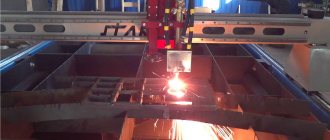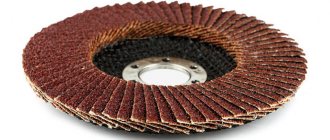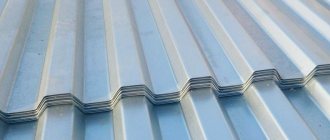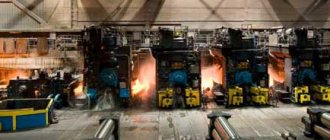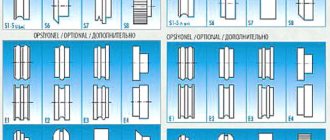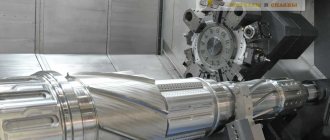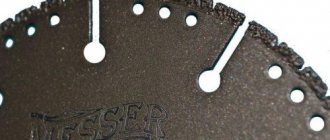Figure 1 - Gas cutting
Structures and products made of concrete/reinforced concrete, just like their metal counterparts, are subject to additional processing: they are adjusted to certain dimensions, openings are made for windows and doors, holes are made in the walls for pipes and communications. For these purposes, oxygen-flux gas cutting is used.
Good performance when performing such work is provided by a flux with high thermal efficiency, which contains iron and aluminum powders in a combination of 75-85% and 15-25%, respectively.
Cutting metals and burning concrete with an oxygen lance
In metallurgy and construction, oxygen is often used to burn metal or reinforced concrete structures. In this article we will look at how cutting metals with an oxygen lance , as well as the specifics of drilling concrete products using point thermal effects.
How it works
The device for implementing this technology has a very simple structure. This is a steel tube of suitable diameter through which oxygen is supplied. One end of the lance tube is connected through a valve and a flexible hose to an O2 source, and the other is applied to the surface to be treated.
To activate the flame, the working end is heated to 1400 °C (an auxiliary heat source is used for this, for example a gas cutter), after which it begins to rapidly oxidize (burn), raising the temperature to 2000 °C and maintaining it without external heating.
To ignite the flame, O2 is supplied at low pressure (about 1 atm), which, after the formation of a stable process, rises to operating parameters (5-6 atm).
As noted above, oxygen lance cutting of metals and concrete structures is often used in the metallurgical and construction industries. Using this method, the following operations are performed:
- drilling of metal and reinforced concrete products;
- scrap cutting;
- removal of casting profits;
- separation of thick slabs.
Since working with O2 carries a certain danger, such cutting must be performed using protective equipment: a shield, a mask and special equipment. Read more about the operating features of this gas and precautions in the article: Technical oxygen: production, operation and use in industry.
Drilling and cutting metals with an oxygen lance
After ignition and stabilization of the flame, the end of the pipe is pressed against the surface of the part. Deepening into the material occurs due to the heat that is released due to the combustion of the metal.
During temperature exposure, it is necessary to periodically perform back-and-forth and rotational actions with the pipe to remove the formed slag.
The result is a round hole, the size of which is usually 1-2 cm larger than the diameter of the spear tube.
This video shows the drilling process with an oxygen lance:
In addition to drilling, this technology allows for cutting parts. For these purposes, a gas cutter is additionally used, which first makes a groove about 15 cm in size into which the spear is inserted. Using this method, you can cut steel blanks 2 m thick:
Cutting large metal parts with an oxygen lance
During the working process, the lance tube is constantly shortened and therefore needs to be periodically replaced. The length of the burnt part primarily depends on the characteristics of the material being processed.
For example, when burning cast iron, about 20 m of pipe is required for each meter of recess (at the same time, the O2 consumption is 35 m³ per 1 m).
Therefore, processing cast iron products using this method has low productivity.
Burning concrete structures
As you know, concrete is a mixture of components, each of which has its own melting point. Thus, expanded clay melts at 1100 °C, feldspars - at 1400 °C, silica - at 1700 °C, alumina - at 2000 °C.
It is important to take into account that these materials do not oxidize under the influence of an oxygen stream, that is, they do not support combustion and do not emit heat on their own. Therefore, when cutting a concrete or reinforced concrete product, it becomes necessary to constantly press the pipe with an approximate force of 30-50 kg.
Since the surface cools very quickly when the molten tube is removed, it is necessary to burn through such non-metallic structures without back-and-forth manipulations, only rotating in one direction or the other.
Burning (drilling) concrete with an oxygen lance
Concrete can be processed in any position, but the most effective is considered to be working on the surface from the bottom up. In this case, the slag flows between the tube and the hole wall under the influence of gravitational force, so the likelihood of slagging is low.
Increased cutting power
To increase the thermal power, a low-carbon steel rod is placed inside the tube. Sometimes it is welded from the outside. In addition to improving the cutting process, this approach reduces material consumption.
It is also necessary to pay attention to the quality of the technical oxygen used, which is important for the efficiency of the process.
Here you can familiarize yourself with the typical volumes of cylinders and forms of delivery of this gas, which complies with GOST 5583 - 78 (purity of at least 99.7%, 1st grade).
An even more effective method for increasing cutting power is the use of a finely dispersed iron-aluminum mixture. When ignited, such a powder forms a powerful torch 5 cm long and a temperature of 4000 ° C. In this case, the end is not pressed against the workpiece, but is placed at a distance of 3-4 cm in order to avoid clogging the hole with slag.
To summarize, it should be noted that there is a sufficient breadth of applications for oxy-lance cutting and drilling, especially considering the technique for increasing power using the above method, due to its excellent productivity and minimal equipment requirements.
This technology can be implemented in almost any conditions, since all you need is a steel pipe and a cylinder filled with high-quality, high-purity O2.
Principle of operation
During the cutting process with a gas cutter, the following happens: the heated metal is burned in a stream of oxygen, which is injected under pressure. First, the alloy is heated to the required temperature using a special burning mixture of acetylene and oxygen. This cutting method, using an oxygen-acetylene cutter, is applied to almost all types of metal (except stainless steel, non-ferrous metals and alloys). For gas cutting of reinforced concrete products, a different method is used.
Oxygen flux cutting
The method is as follows: a flux (a substance that promotes the formation of slag and improves the quality of the metal during melting) based on iron powder, which releases an additional amount of heat during combustion, reduces the concentration of constituents impurity material and liquefies the slag.
In oxygen-flux cutting, ignition of the flux begins above the surface of the material being cut, and complete combustion occurs in the cut cavity. In practice, this distance is selected depending on the material being cut and ranges from 15 to 50 mm.
Using special equipment, reinforced concrete structures with a thickness of 90 to 300 mm are cut. In this case, the passage speed is 100 mm per minute. To form a good jet flow, nozzles are used in the shape of a cylinder and a cone narrowed towards the outlet. For cutting thick reinforced concrete structures, the oxygen-lance cutting method is used.
Oxygen lance cutting
A more productive method of gas cutting for concrete is a powder lance, with which work can be carried out on structures with a thickness of 100 to 2000 mm. The powder lance has the properties of a conventional oxygen lance, which is designed for deep penetration into the material, and the properties of oxygen-flux cutting.
Figure 2 — Scheme of oxygen-lance cutting
The principle is as follows: using a special automated tube, a mixture of iron and aluminum powder is supplied to the cutting site, the combustion of which releases additional heat. In order for an oxygen lance 3000 - 6000 mm long to supply oxygen to the place where the hole was burned, a special UFR-5 installation is used.
The device uses a thick-walled metal pipe made of steel with a maximum diameter of 20-35 mm filled 60-65% with steel rods or a thin-walled gas pipe of the same diameter, wrapped on the outside with steel wire with a diameter of 3-4 mm, through which oxygen is supplied, which is involved not only in combustion , but also in blowing out products formed as a result of combustion.
Knowing the thickness of the structure, you can calculate the amount of resources spent on cutting based on the data in Table 1.
Table 1 - Modes of oxygen-flux burning holes in reinforced concrete
| Depth, mm | Diameter of burnt hole, mm | Flux consumption, kg/h | Oxygen pressure, kg*s/cm2 | Oxygen consumption, m3/h | Consumption of steel tube, m/m hole length | Spear diameter, inches | Burning speed, mm/min |
| Up to 500 | 50 — 55 | 30 | 6 — 7 | 60 — 80 | 4 | 3/8 | 120 — 180 |
| 500 — 1000 | 55 — 60 | 30 | 8 — 10 | 80 — 100 | 4 — 5 | 3/8 | 80 — 120 |
| 1000 — 1500 | 60 — 70 | 30 | 10 — 12 | 100 — 120 | 5 — 6 | 3/8 | 40 — 80 |
Oxygen lance cutting
In metallurgy and construction, oxygen is often used to burn metal or reinforced concrete structures. In this article we will look at how cutting metals with an oxygen lance , as well as the specifics of drilling concrete products using point thermal effects.
Concrete cutting: oxygen lance drilling. waterjet
As we know, concrete is a very rigid and durable material, as a result of which its mechanical processing is associated with some difficulties. An operation such as cutting concrete requires the use of special equipment and adherence to a certain technology. Based on this, in this article we will look in detail at what and how it is possible to cut concrete.
Types of concrete cutting
Today, builders use a couple of methods for cutting concrete:
- Oxygen lance drilling;
- Diamond cutting;
- Waterjet cutting.
Now let’s take a closer look at the highlights of each technology.
Oxygen lance drilling
This cutting method involves the use of an oxygen lance - a thick-walled metal pipe into which oxygen is supplied. The oxygen lance is heated to a high temperature (1350-1400 degrees) with the help of external sources, for example, a welding arc or a cutter flame. As a result, one end of the pipe ignites, after which the heating source is removed.
With a constant supply of oxygen, the end of the pipe burns intensely and heats up to 2000 degrees. To increase the thermal power, a steel rod is usually inserted inside the pipe.
During drilling, the spear is pressed against the surface of the concrete with great force, which allows it to overcome the resistance of densely melting slag.
Among the highlights of this method, the following points can be highlighted:
- During drilling, concrete is not oxidized by an oxygen stream and, at the same time, does not release its heat.
- When the oxygen lance is removed, the surface immediately hardens.
Due to these circumstances, no reciprocating movements are performed during cutting. But, in order to increase the cutting efficiency, the pipe must be rotated during cutting, without allowing the flame to die out. Based on this, this technology is called drilling.
In most cases, oxygen lance drilling is used to make openings in cement walls.
Waterjet method
Waterjet cutting of concrete is almost as common as diamond cutting. Much more often it is used when dismantling cement structures, but this technology also makes it possible to purchase openings in the wall with high accuracy.
This method is also called cold cutting. It consists of applying a stream of water with an abrasive under high pressure to the cement surface. Much more often, small sand is used as an abrasive.
Cutter UFR-5
UFR-5 is used in both manual and machine oxygen-flux cutting. It is also used in oxygen-lance (powder) cutting for pinpoint burning of holes in materials.
Figure 3 — Scheme of operation of the UFR-5 installation
Explanation for Figure 3:
- Spear holder.
- Flux feeder.
- Hand cutter.
- Machine cutter.
The fuel is propane or butane combined with oxygen. The injector supplies flux from the tank with a stream of cutting oxygen. In the cutting zone it creates a triple effect:
- thermal;
- chemical (liquid slags are formed in the cut - they are removed by a stream of oxygen);
- abrasive (unburned powder particles and refractory oxides from the surface of the edges are erased and then completely removed).
Figure 4 - Installation of oxygen-flux cutting UFR-5
Explanation for Figure 4:
- Cart.
- Cyclone.
- Flux feeder.
- Oxygen reducer.
- Cutter.
- Hoses.
Table 2 shows the concrete processing speed and material consumption for various cutting methods.
Table 2 - Concrete processing speed and material consumption depending on the cutting method
| Cutting method | Concrete processing speed cm cub./min | Material consumption per 1 cubic meter dm of concrete removed | ||
| pipes, kg | oxygen, cubic meters | flux, kg | ||
| Oxygen-flux | 100 | — | 5,5 | 4,5 |
| Oxygen-lance | 300 | 0,5 | 2,5 | 2,5 |
Concrete cutting: oxygen lance drilling. waterjet
As we know, concrete is a very rigid and durable material, as a result of which its mechanical processing is associated with some difficulties. An operation such as cutting concrete requires the use of special equipment and adherence to a certain technology. Based on this, in this article we will look in detail at what and how it is possible to cut concrete.
Diamond cutting
Diamond cutting of concrete is the most popular today, because it has a number of undeniable advantages, such as:
- Versatility;
- Accessibility , since it is possible to use a simple angle grinder (grinder) and a diamond wheel to cut concrete.
- Compact equipment;
- High speed;
- No vibration.
Experienced diamond cutting equipment is, in most cases, equipped with a vacuum cleaner to collect dust and a water supply system. This allows the disk to be cooled during operation and reduces dust emissions.
This method can be used to cut cement walls and floors. Large cutting depths depend on the type of equipment and blade diameter.
When using this method, it is fundamentally important to choose the right diamond blade, depending on the type of concrete. If the structure is reinforced, then it is necessary to use turbo-diamond discs with a wave casing. It goes without saying that the price of such circles is the highest, but for that they are the most reliable, effective and durable.
Advice! Not all types of concrete require special tools for machining. For example, cutting aerated concrete can be done with a simple hacksaw.
Cutting a cement surface with a grinder
Now we will take a closer look at the process of cutting concrete with a grinder, since this method is the most common and the only one available in everyday life. It goes without saying that it is easiest to use the services of experts, but first determine the price of concrete cutting.
Given the relative simplicity of this process, it is much more profitable to do the work yourself. The only thing is that you first need to familiarize yourself with the technology and some cutting rules, on which not only its effectiveness, but also your safety depends.
This work has several stages:
- Definitions of concrete type;
- Selecting a diamond blade;
- Concrete cutting.
Definitions of concrete type
Concrete is not uncommon in various types, it can be reinforced or without reinforcement. Sand, granite chips or crushed stone can be used as filler.
In addition, over time, the structure of steam concrete changes. Young concrete is more abrasive, while old concrete is more durable. To find out the type of concrete, it is possible to chop off a small piece of the material and study its structure, or give it to an expert.
Disk selection
When choosing a disk, pay attention to the following points:
| Type of concrete | The choice of disc type primarily depends on the type of concrete. Based on this, all information taken about him must be given to the seller. It goes without saying that the seller must be qualified, so you should buy the tool in large specialized stores. |
| Maximum permissible rotation speed | The high rotation speed of the grinder should be less than the maximum permissible rotation speed of the disk. This parameter is very important, since the safety of work depends on it. |
| Fastening | The disk must be securely fixed; any play is unacceptable. |
Equipment
The main equipment for gas cutting is a cutter. The kit includes: a nozzle for welding and melting.
Thanks to the cutter, you can control the dosage of the gas mixture and oxygen. Also, with the help of this equipment, the flammable mixture is ignited and a flame is supplied to the processing site.
The cutter consists of two blocks: cutting and heating. The first is represented by an oxygen stream outlet tube, a valve and an internal type mouthpiece.
The heating block includes valves that are designed to regulate the pressure of the gas mixture and oxygen. There is also a supply tube, an external mouthpiece, a mixing chamber and an injection cell.
Cutters are either manual or machine. The latter are stationary, so for repair work it is preferable to use manual ones.
Additionally, the following gas cutting equipment is used:
- reducer – designed to reduce pressure;
- device for changing pressure;
- steel cylinder with gas and oxygen;
- connecting hoses.
Before using the equipment, it is important to check its serviceability in order to avoid explosion of the cylinder or reducer. The cutter is pre-purged with oxygen.
